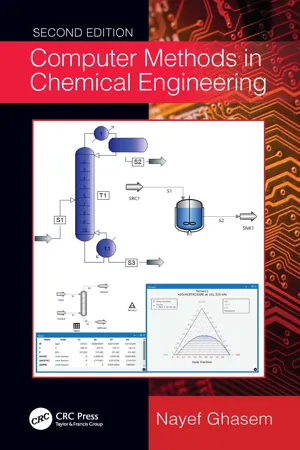Technology & Engineering
Peng Robinson Equation of State
The Peng Robinson Equation of State is a mathematical model used to predict the behavior of gases and liquids. It takes into account the molecular size and attractive forces between molecules, providing more accurate predictions of fluid properties such as pressure, volume, and temperature compared to simpler equations of state. This makes it valuable in various engineering applications, particularly in the design and operation of chemical processes.
Written by Perlego with AI-assistance
Related key terms
Related key terms
1 of 4
Related key terms
1 of 3
3 Key excerpts on "Peng Robinson Equation of State"
- Ali Danesh(Author)
- 1998(Publication Date)
- Elsevier Science(Publisher)
Developments in Petroleum Science , Vol. 47, Suppl. (C), 1998ISSN: 0376-7361doi: 10.1016/S0376-7361(98)80026-54 Equations of StateThe equality of fugacity of each component throughout all phases was proved, in Chapter 3 , to be the requirement for chemical equilibrium in multicomponent systems. The fugacity coefficient, φi , defined as the ratio of fugacity to pressure, of each component in any phase is related to pressure, temperature and volume by Eq.(3.31) ,(3.31)The fugacity coefficient can, therefore, be determined from the above with the aid of an equation relating pressure, temperature, volume and compositions, that is, an equation of state (EOS).In general, any equation of state which provides reliable volumetric data over the full range of the integral in Eq.(3.31) can be used to describe the fluid phase behaviour. Several types of EOS have been successfully applied to hydrocarbon reservoir fluids.The simplest, and highly successful equation, is the semi-empirical van der Waals type EOS with two or three parameters. Since 1873, when van der Waals improved the ideal gas equation by including parameters that represented the attractive and repulsive intermolecular forces, the equation has been revised and modified by numerous investigators. Other equations with many parameters have also been used to describe the phase behaviour, some with reasonable success. Amongst these equations, the Benedict-Webb-Rubin (BWR) type[l], which is an empirical extension to the virial EOS, can be applied to both liquid and vapour phases of reservoir fluids. These equations provide no additional reliability in phase behaviour studies, in spite of their complexity, in comparison with the van der Waals type EOS. They are, however, valuable tools to describe volumetric behaviour, particularly of pure compounds, due to their large number of parameters, hence, high flexibility.- eBook - ePub
- Saeid Mokhatab, John Y. Mak, Jaleel V. Valappil, David Wood(Authors)
- 2013(Publication Date)
- Gulf Professional Publishing(Publisher)
th Annual Fall Technical Conference and Exhibition of the Society of Petroleum Engineers of AIME; 1982; Sept. 26–29.56. Nghiem LX, Li Y-K. Computation of Multiphase Equilibrium Phenomena with an Equation of State. Fluid Phase Equilibria . 1984;17:77–95.57. Orozco CE, Tiffin DL, Luks KD, Kohn JP. Solids Fouling in LNG Systems. Hydrocarbon Processing . 1977;56:325–328.58. Peng D-Y, Robinson DB. A New Two-Constant Equation of State. Ind Eng Chem Fundam . 1976;15:59–64.59. Peng D-Y, Robinson DB. A Rigorous Method for Predicting the Critical Properties of Multicomponent Systems from an Equation of State. AIChE Journal . 1977;23:137–144.60. Peters G, Wilkinson JH. “Inverse Iteration, Ill-Conditioned Equations and Newton’s Method”, SIAM. Rev. 1979;21:339–360.61. Poon DPL. Phase Behavior of Systems Containing Nitrogen, Methane, and Propane . PhD Thesis Ottawa, ON, Canada: University of Ottawa; 1974.62. Poon DPL, Lu BC-Y. Phase Equilibria for Systems Containing Nitrogen, Methane, and Propane. Adv Cryog Eng. 1974;19:292–299.63. Prausnitz JM, Lichtenthaler RN, Gomes de Acevedo E. Molecular Thermodynamics of Fluids-Phase Equilibria . third ed 1999; Prentice Hall PTR: Upper Saddle River, New Jersey, NJ, USA.64. Press WH, Teukolsky SA, Vetterling WT, Flannery BP. Numerical Recipes: The Art of Scientific Computing . 2nd Edition New York, NY, USA: Cambridge University Press; 1992.65. Ramírez-Jiménez E, Justo-García DN, García-Sánchez F, Stateva RP. VLL Equilibria and Critical End Points Calculation of Nitrogen-Containing LNG Systems: Application of SRK and PC-SAFT Equations of State. Ind Eng Chem Res. 2012;51:9409–9418.66. Reid RC, Prausnitz JM, Poling BE. The Properties of Gases and Liquids . 4th Edition New York, NY, USA: McGraw-Hill; 1987.67. Rowley RL, Wilding WV, Oscarson JL, Yang Y, Zundel NA. DIPPR Data Compilation of Pure Chemical Properties . Design Institute for Physical Properties Provo, UT, USA: Brigham Young University; 2006.68. Schindler DL. The Heterogeneous Phase Behavior of the Helium-Propane, Nitrogen-Propane, and Helium-Nitrogen-Propane Systems - eBook - ePub
- Nayef Ghasem(Author)
- 2021(Publication Date)
- CRC Press(Publisher)
3 ].The constants a and b are determined as follows:p =(1.9)-R TV - baVV + b+ b ( V - b )a = 0.45724(1.10)[ 1 + m ( 1 -R 2T c 2p cT r) ]1 / 2b = 0.07780(1.11)RT cp cm = 0.37464 + 1.54226 ω - 0.26992(1.12)ω 2(1.13)T r=TT cwhere ω is acentric factor, Tc and pc are critical temperature and critical pressure, respectively, and V is specific volume.Example 1.4: Specific Molar Volume of N-Hexane Estimate the specific molar volume of n-hexane at 1 atm and 25°C. Compare the manual calculation with those predicted from the available software packages.Solution
Polymath Calculation
Equations 1.9 –1.13 can be easily solved using the polymath program (Figure 1.13 ). The calculated molar volume is 131 cm3 /mol (0.131 m3 /kg mol).FIGURE1.13Polymath programs determined the specific volume (0.131 m3 /kg mol) calculated for the case in Example 1.4 .Unisim Simulation
UniSim calculates the molar volume of pure n-hexane at 1 atm and 25°C. Peng–Robinson is a suitable fluid package for estimating the fluid properties of the given components. Select a material stream, specify the temperature, pressure, flow rate (e.g., 100 kgmol/h), and composition. From Worksheet/Properties menu (Figure 1.14 ), the UniSim predicted molar volume is 0.131 m3
Index pages curate the most relevant extracts from our library of academic textbooks. They’ve been created using an in-house natural language model (NLM), each adding context and meaning to key research topics.
Explore more topic indexes
Explore more topic indexes
1 of 6
Explore more topic indexes
1 of 4


